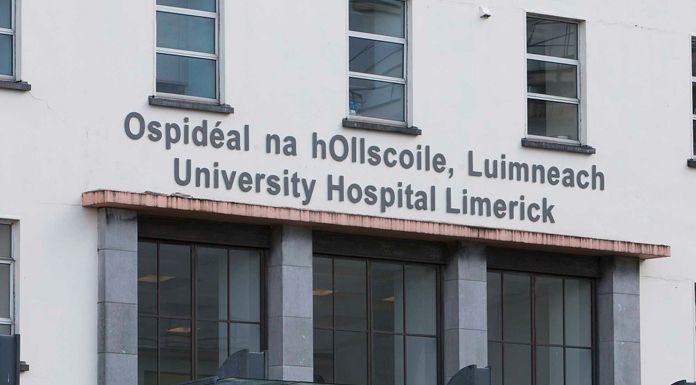The Irish Patients Association insists preparation for a winter of high demand for services at the region’s main hospital must begin now.
It comes on a day when the Irish Nurses and Midwives Organisation says 90 patients are waiting for a bed at University Hospital Limerick – just one below yesterday’s all time record total for the month of October.
The UL Hospitals Group says attendances to its emergency department continue to increase, and they’re managing high demands for services on a number of fronts, including a COVID-19 outbreak impacting four inpatient wards.
Stephen McMahon of the Irish Patients Association says winter planning in the Midwest should start now.
UL Hospitals Group statement:
We deeply regret that so many patients are currently experiencing such lengthy wait times for a bed in University Hospital Limerick (UHL). These are not the circumstances in which we wish to provide care, and we are doing everything we can to ensure that wait times are minimised.
We acknowledge the extraordinary efforts of our staff in the face of current service pressures. We are managing high demand for services on a number of fronts, including significant numbers of COVID-19 patients; an outbreak that has impacted four inpatient wards; and a surge in emergency presentations at the hospital that has been sustained for several months at this point.
Our main priority in managing the COVID-19 outbreak has been to keep the hospital safe for patients in need of emergency care, and for those scheduled to attend for surgery, diagnostic investigations and outpatient appointments. While cancelling elective care is included in our escalation plan as a matter of last resort, this is not a decision to be made lightly and affects many patients who have already faced long delays in care due to the pandemic and the cyber attack.
While COVID-19 outbreaks impact on patient flow, the additional bed stock at UHL introduced since August 2020 has enabled us to keep vulnerable patients safe, including haematology, oncology and renal patients; to provide a safe pathway for people attending UHL for surgery; and to isolate COVID-positive patients. These new beds have allowed to keep the hospital safe in a way that results in a minimum number of beds blocked due to infection prevention and control guidelines.
It is unfortunate that the additional bed capacity has not had a more significant impact in reducing the number of admitted patients waiting for a bed. The pandemic and the sustained surge in non-COVID care presenting to hospitals around the country in recent months are significant unforeseen factors.
The latest available data shows that in the year to date (August 31st), attendances to our ED increased by 14% on the corresponding period last year and that emergency admissions increased by 11%. Compared to 2019, there was an increase of 4% in ED attendances and 4% in emergency admissions for the corresponding period.
We had at all times said the 60-bed block would only go some of the way in meeting the acknowledged historical shortage of inpatient bed capacity in the Mid-West. In addition to bed capacity, reducing overcrowding in our hospitals depends on whole system approaches around integrated care, admissions avoidance, community access to diagnostics and patient flow initiatives, all of which are committed to under Slaintecare.
This year, UHL has provided more inpatient care than ever before. The number of inpatients discharged in the second quarter of this year, at 9,451, was 25% up on the corresponding period in 2020 and 30% up on the same period in 2019.
As well as allowing us to care for more patients, the additional single room capacity has allowed us protect our most vulnerable patients. It has also allowed us to better manage outbreaks and follow best practice around infection prevention and control. The value of this additional capacity must not be underestimated.
None of this is to minimise the anxiety people are feeling when they experience long waits for an inpatient bed. We are very sorry that any patient has to wait a long time for inpatient beds, and we will continue working to ensure that wait times are minimised and they get the care they need.
We continue to follow our escalation plan that includes additional ward rounds to accelerate discharges and identify patients for transfer to our Model 2 hospitals. We continue to use our Community Intervention Team (CIT) and Early Supports Team (EST) services to assist with the timely discharge of patients. We are also in daily communication with our colleagues in HSE Mid-West Community Healthcare, in order to expedite discharges.
October to date has shown no trend of reversal in demand for emergency services. Last month, average daily attendances at the ED were 240, 23% higher than the 195 daily average in 2019, the last full year pre-pandemic. During September, daily attendances exceeded 250 on 14 days of the month, reaching a high of 290. On only two days of the month were attendances fewer than 200. This trend has continued into October, which has seen on average 243 people attending on weekdays, and a relatively high average of 190 attendances for the two weekends in the month so far.
We ask people to consider all appropriate care options before attending the ED. For treatment of non-life-threatening injuries such as broken bones, dislocations, sprains strains, wounds, scalds and minor burns, the Injury Units in Ennis and Nenagh are open from 8am to 8pm, and St John’s from 8am to 7pm. Please see the HSE website on the range of services and treatments available in our Injury Units. Anyone with less serious illness or conditions should contact their GPs or out-of-hours GP services.
However, please be assured that if you are seriously injured or ill or are worried your life is at risk the ED will assess and treat you as a priority.
We apologise to any patient who has experienced a long wait for admission to UHL during this period of exceptionally high demand for our services.









